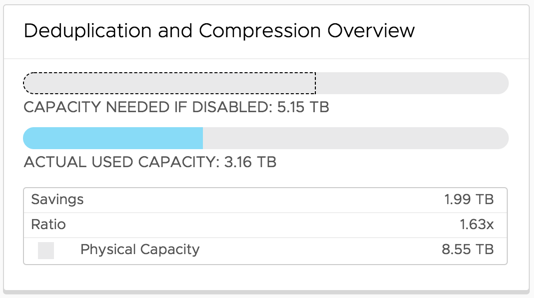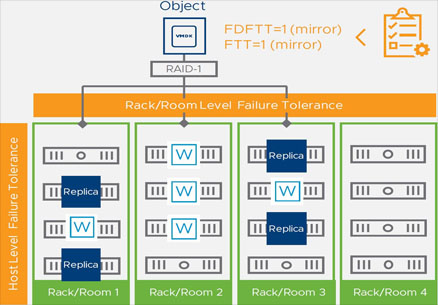
As we all aware VMware announced their new updates on the VMworld 2018 U.S and I have published my post on VSAN 6.7 U1 And VSAN Beta Announcement – VMworld . In this post, I will be sharing more details of whats’s new in in vSAN 6.7 Update 1 release.

Below is the summary of important innovations of vSAN 6.7 Update 1

With vSAN Update 1, newest version of vSAN VMware has introduced new features and enhancements to configure and manage VMware Software Defined Storage solution.
Driver & Firmware updates using Update Manager
VMware Update Manager has integrated for better and easy operation for vSAN clusters. All ESXi, driver, and firmware update functions previously handled by the Configuration Assist workflow have been moved to Update Manager.

VSAN Cluster Configuration – Quickstart
vSAN 6.7 Update 1 introduces new “quickstart” guided cluster creation wizard gives administrators a streamlined mechanism for deploying vSAN, and non-vSAN, clusters .Not only to create new cluster creation , it allows you to add new and existing hosts .
It is very easy and systematic configuration wizard makes creating a production-ready vSAN cluster effortless. Cluster Quickstart handles initial deployment, as well as the process of expanding the cluster as needs change.

The Cluster Quickstart wizard workflow includes below tasks and more to ease the deployment process:
The Cluster Quickstart wizard works great for configuring vSAN clusters added to an existing vCenter 6.7 U1 deployment, as well as a great next step after using vSAN Easy Install to bootstrap a new vCenter onto the first host in a new vSAN cluster.
Reference:- StorageHub.
Decommissioning and Maintenance Mode
This safeguard feature will support on host maintenance activity , if you want to put a host into maintenance mode or to decommission a host, the EMM (Enter Maintenance Mode) will run a couple of pre-checks: When other host(s) are already in maintenance mode, when resync operations are in progress or when other decommissioning operations are already in progress.
Each vSAN host in a cluster contributes to the cluster storage capacity, entering a host into maintenance mode takes on an additional set of tasks when compared to a traditional architecture.When performing maintenance and decommissioning activities on vSAN hosts ,vSAN will now perform a full simulation of data movement to determine if the process of entering maintenance mode will succeed or fail before it even starts. This will prevent unnecessary data movement and provide a result more quickly to the administrator.

Reference – Storage HUB
New warnings have been added to entering maintenance mode activities to ensure that there are no other hosts already in maintenance mode or resync activity current performing.
For cases where an administrator needs to adjust the time vSAN waits before it begins to rebuild data to reestablish compliance with storage policies, a new “object repair timer delay” setting is now in the UI.
Improved Cluster Capacity Reporting
With new update visibility of the storage capacity in vSAN has been improved and from the Monitor tab in vSAN you will be able to track historical capacity statistics but you will also be able to display the current usable capacity based on storage policies. This makes it easy to find out how changing a vSAN storage policy will affect the capacity in use on disk.
However, always remember that when you change a storage policy for an VM, for example from FTT=1 to RAID=5, the innitial VM (FTT=1) and its mirrored copy will not be removed until the new RAID=5 version has been created. This means that temporarily, this VM will consume the following disk space in percent: 200% + 133%. Once the RAID=5 version has been completed, the FTT=1 version will be destroyed.

Having a better understanding of past, present, and future capacity utilization is a top-of-mind concern for administrators
In vSAN 6.7, Administrators can easily:


Reference – Storage HUB
PowerCLI / RVC
VMware is slowly moving away from RVC and moving more towards PowerCLI to manage vSAN. Also some RVC commands have been replaced by PowerCLI cmdlets, and some new cmdlets are exclusive to the new PowerCLI 10.2. and the new version of PowerCLI for vSAN will give you a greater visibility into:
Simplified and More vRealize Operations Intelligence
Integration between vROPS and the vCenter UI has been increased and dashboards are now capable of displaying vSAN Streched Cluster intelligence.
In vSAN 6.7 vRealize Operations within vCenter provided an easy way for customers to see basic vRealize intelligence with vCenter. And new in vSAN 6.7 U1, vRealize Operations dashboards have the ability to differentiate between normal and stretched vSAN clusters, displaying appropriate intelligence for each

An incredible number of metrics are exposed to assist with monitoring and issue remediation. vRealize Operations makes it easier to correlate data from multiple sources to speed troubleshooting and root cause analysis.
Reference – Storage HUB
Efficient Infrastructure
vSAN is an efficient infrastructure choice which helps in lowering the total cost of ownership. Space reclamation, enhanced networking support for some architectures, as well as better sizing tools lead to even more efficiencies with vSAN. With the newest version of vSAN, VMware has also strived to reduce the resource utilization and to provide optimized topologies.
TRIM/UNMAP Support
Popular workloads can use less storage through the process of automatic space reclamation. The addition of TRIM/UNMAP support can automatically reclaim capacity that is no longer used, reduces the capacity needed for popular workloads without administrator interaction.
While VMFS has allowed us to reclaim space from within the Guest OS’s for a longer time, vSAN did not support it, until now. vSAN 6.7U1 allows us to reclaim guest OS capacity. However, guest OS innitiated TRIM/UNMAP will only be supported for a handful of OS’s.

Note:- TRIM/UNMAP probably will be vHardware dependent, but so far no communication has bene made as to which version of vHardware will support TRIM/UNMAP . TRIM/UNMAP will be supported in a variety of Guest Operating Systems, virtual hardware configurations, and virtual machine configurations.
Reference – Storage HUB
Improved flexibility for Stretched clusters
Mixed MTU Support for 2 Node and Stretched Clusters
In a stretched cluster environment, the ability to isolate witness traffic using dedicated uplinks was a powerful enhancement made to vSAN 6.7. vSAN 6.7 U1 introduces additional levels of flexibility to this feature with the support of different MTU sizes configured for witness traffic, and the Inter-site link used for vSAN data traffic.

This allows for a user to configure vSAN to use perhaps larger frame sizes on the vSAN data network while keeping the witness uplinks going to the more affordable witness site to a more common standard MTU size. This enhancement will give additional flexibility in accommodating a wider variety of customer topology conditions and reduce potential network issues.
Reference – Storage HUB
Secondary Levels of Protection for Non-Stretched clusters
vSAN now allows you to create nested fault domains for non-strtched clusters (RPQ only). In all previous releases from vSAN you were unable to protect your site from rack/floor failures and node failures simultaneously, this was simply impossible to achieve.With vSAN 6.7 Update 1 you are able to install a nested fault domain within your non-stretched cluster.
In case you are wondering if rebuilds and repairs are supported on this new feature, yes advanced repairs and rebuilds are supported.

Rapid Support Resolution
Faster resolution, quicker diagnosis, and simplified self-help make vSAN Supportability even better. vSAN ReadyCare has simplified the support process by reducing requirements of customers, and speeding time to resolution through faster insight and integrated self-help in vSAN.
Improved Health Check Guidance
with vSAN 6.7 Update 1 there are Improved Guidance of Health Checks and Recommendations are available .vSAN health check feature has the ability to ensure that an environment meets hardware and software configuration requirements. vSAN 6.7 U1 extends this feature even more, with a more robust way of handling multiple approved firmware levels for storage controllers. Storage controller firmware checks will tell you if the firmware that you are running is still supported. And you don’t have to upgrade to the latest and greatest all of the time if you which to remain on a supported stable version.

A new Unicast network performance health check and test ensures that proper continuity is achieved between vSAN hosts and will report network bandwidth results for the tests.vSAN 6.7 U1 also introduces functionality that is now accessible in the UI. Health checks can be silenced granularly, directly in the UI, as well as being able to purge inaccessible swap objects that are no longer needed.These improvements improve the effectiveness of vSAN’s ability to not only recognize issues but remediate them more quickly.
Also a couple of new controls will be introduced in the UI:
Reference – Storage HUB
Enhanced Support Diagnostics
The new Purpose-built VMware support diagnostics within vSAN will assist GSS to resolve customer cases faster.
The on-demand network diagnotics mode, which will collect statics at a one second sample rate, can still be enabled per GSS guidance and the log files will be send to GSS. Remember that private data, server names and so on can be obfuscated from GSS and enabled again in the log files send to GSS . These advances help reduce the need to request log support bundles from the hosts, and when they are absolutely necessary, will contain even more critical data for better root cause analysis.

vSAN 6.6.1 introduced “vSAN Support Insight,” VMware’s method of automatically collecting vital infrastructure telemetry data about an environment for the VMware technical support engineers in our global support services group.

Native health checks, more self-help tools, better reactive support with vSAN Support Insight, and participation in the VMware Customer Experience Improvement program, provide for an overall enhanced support experience. VMware can rapidly understand a customer’s environment, perform root cause analysis to identify the cause of the problem, and deliver proactive support based on trends and analytics.
Reference – Storage HUB
Updated Sizing Tools
vSAN 6.7 update 1 introducing new capabilities that simplify planning to help customers size the most efficient deployment for their environment.

Updates to the HCI Assessment and vSAN Sizer tools work even better together to provide a more streamlined and flexible sizing and infrastructure selection process to ensure the most efficient configuration for new deployments.
Check the Tool from vSAN Ready Node Sizer


What’s New VMware vSAN 6.7 Update 1 Technical Review Video